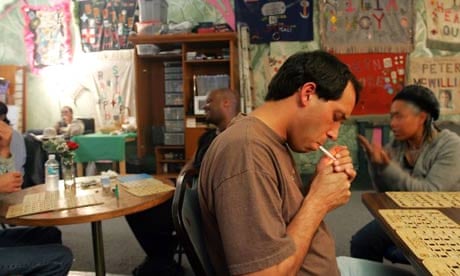Marcy Dolin, of Rohnert Park, California, smokes eight joints (marijuana cigarettes) every day, and eats a marijuana cookie before he goes to bed every night. He prefers the peanut-butter cookies.
A 71-year-old man who has struggled with multiple-sclerosis for over half his life, Dolin is not the typical drug user often parodied in popular culture. He does not smoke recreationally, but rather because marijuana is the only thing that takes away the pain and stops the muscles spasms.
"Without [marijuana], I would be living on morphine and other horrible drugs. I couldn't do that to my family," he recently told the New York Times. "That's no life, and I would have ended it. That's the truth."
Dolin is not alone. Across the United States, people struggling with chronic illness increasingly are questioning US policy toward marijuana, a homeopathic substance that until 1937 was, for the most part, legal and regulated. Friday marks the 40th anniversary of the "war on drugs". And what do we have as a result?
Hundreds of billions of dollars wasted in the midst of a fragile economy, the financial and social cost of imprisoning hundreds of thousands of offenders annually, and patients like Dolin who continue to suffer due to our failed policies. When compared to other drugs, recent clinical trials have shown that marijuana is exceedingly successful in relieving pain, without the serious side-effects that often plague users of other medications.
"I used to take a drug called Neurontin, and I just never stopped crying," Dolin continues. "I was in a fog, totally depressed. I told my doctor that I was going back to just marijuana; he said he would have me arrested if he could. What are they going to do? I'm 71 years old. Are they going to put me in jail? I'm not hurting anybody. It's just here in my own house."
Debilitating pain in the nervous system can be caused by cancer, HIV/Aids, multiple sclerosis, and diabetes; this pain can also be a side-effect of the recommended treatments for these various conditions. About a third of patients with HIV/Aids suffer from this excruciating pain in their nervous system – much of it a response to the antiretroviral therapy that is the initial treatment for HIV patients. Yet there is no adequate approved treatment to mitigate the pain. As a result, some patients reduce or discontinue treatment because they can neither tolerate nor eliminate the debilitating side-effects. Marijuana has been proven to alleviate the effects of both the illness itself, and the prescribed medication used to treat it.
While the advantages of legal medical marijuana are clear, the potential benefits of full legalisation should also be considered, especially when evaluating the economic advantages of its regulation and taxation. Currently, Americans face dim economic prospects. Since the market crash of 2008, unemployment has remained staggeringly high as businesses have either closed or moved overseas. The US's debt has doubled in the past ten years, the poverty rate is the highest it has been in 15, and, adjusted for inflation, the median income has hardly moved since the 1950s.
Meanwhile, New York City spends $75m per year to enforce the prohibition of marijuana. A recent study by the Drug Policy Alliance shows that between 2002 and 2010, New York City spent between $350m and $700m to arrest and charge people with low-level marijuana possession. Against this background, the city presently debates which schools to close and which public employees to lay off – decisions that will only deepen the impact of the recession.
Another report estimates that nationwide government spending on enforcing marijuana laws costs $7.7bn per year. A look at Montana, however, shows how the state has been given a much needed bump from the legalisation of medical marijuana. Since 2004, investors have put millions of dollars into the newly legalised medical marijuana sector, creating jobs for professional horticulturists, construction workers and electricians put out of work by the recession. This small marijuana industry created 1,400 jobs last year – this in a state with less than a million people.
A change in US marijuana policy would mean significant savings. Full legalisation would bring in an estimated $2.4bn annually if marijuana were taxed like most consumer goods, and $6.2bn annually if it were taxed at rates similar to those on alcohol and tobacco. In fact, legalisation of marijuana – the cessation of prosecutions and tax revenue – could put more than $13bn into government coffers. That would equal the entire budget of the department of labour. Maybe with a budget twice as large, it could focus on creating jobs and getting Americans back to work.
Why should sick patients like Dolin continue to suffer without the medical treatment they need? At a time when tens of millions of people can't find work, and while pay and healthcare benefits are being cut, why should our sick economy be deprived of so much needed revenue? On this 40th anniversary of the failed drug war, we must, instead, envision a drug policy that is patient-centred and fiscally responsible – a policy that puts Americans first.

